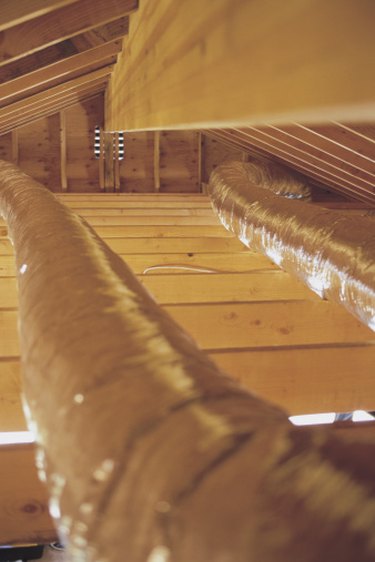Things You'll Need
Ozone generator
Plastic covering

Mold in air conditioning ducts adds a unique problem to an already bothersome issue. The ducts are hard to reach, and certainly can't be cleaned thoroughly like rooms in the house. Then, once mold infests the ducts, mold spores can be circulated throughout the house when the AC runs, which can cause mold problems in other areas, as well as health problems. The sooner you treat a mold problem, the easier it will be to get rid of, regardless of where the infestation occurs.
Step 1
Set up an ozone generator near the duct system's air intake. The intake can usually be found with a duct connected to the air conditioning unit itself. You may need to unscrew the duct so the ozone can go through the system. Ozone generators can be rented or purchased online, or at air purifier stores. The store that sells the generator should be able to help you get the right size based on the size of your house.
Video of the Day
Step 2
Cover any vents where the ducts may release air, using plastic. Use the ozone generator to perform what is called an "ozone shock treatment"--this involves using high levels of ozone to kill mold and bacteria.
Step 3
Set the ozone generator to its highest setting and run it for several hours. The time it takes will depend on the size of your house, and the size of the ozone generator. Most ozone generators come with a timer that will automatically shut the unit off so the air can revert back to oxygen.
Step 4
Uncover the vents throughout the house. If the air smells acrid at all, open windows to ventilate the house. An acrid smell indicates a high concentration of ozone.
Step 5
Reconnect the air duct to the AC unit if you had to disconnect it, and run the AC as you normally would. The air circulation will push most of the dead mold out of the system.
Tip
A serious mold problem may require a professional duct cleaning service, especially if the problem persists after an ozone shock treatment.
Replace the filter on the AC soon after the treatment so dead mold spores don't linger in the AC's system.
Running an air purifier in the house will also help catch lingering mold spores.
Warning
While performing an ozone shock treatment, if you notice an acrid odor, turn off the ozone generator. This indicates that ozone is leaking into the house. Ozone shock treatment is only meant for unoccupied areas.
Video of the Day